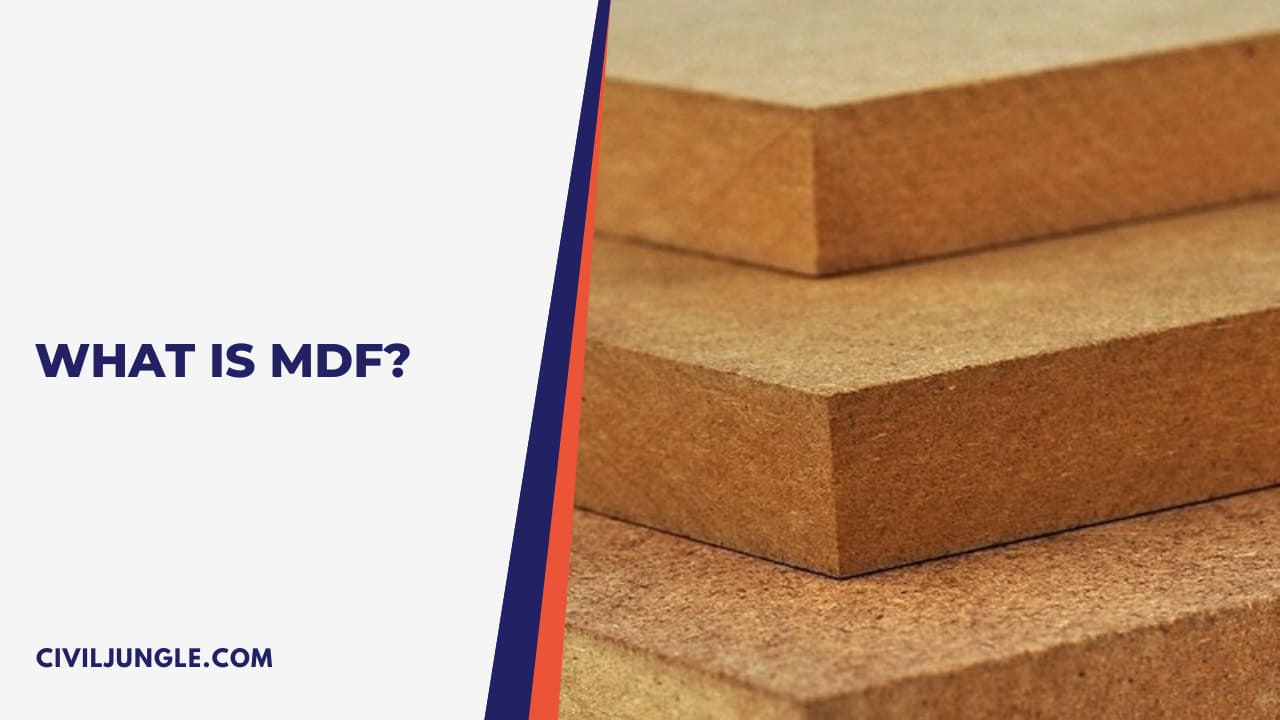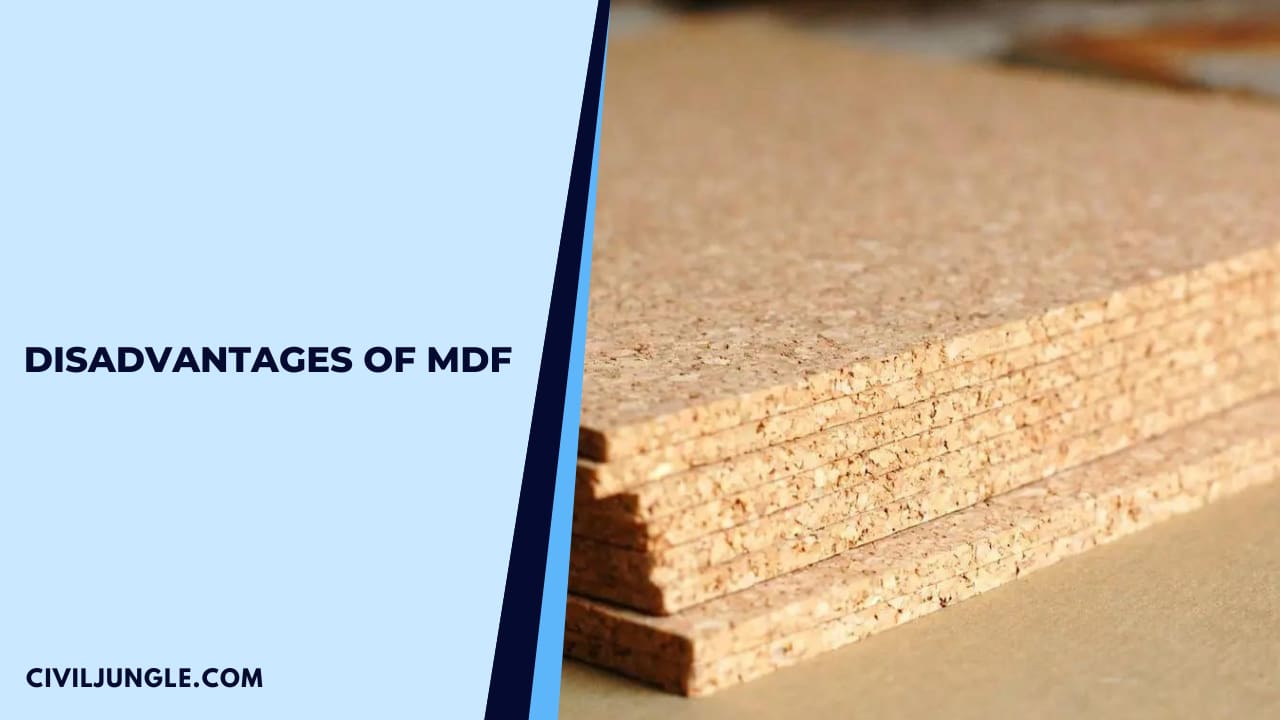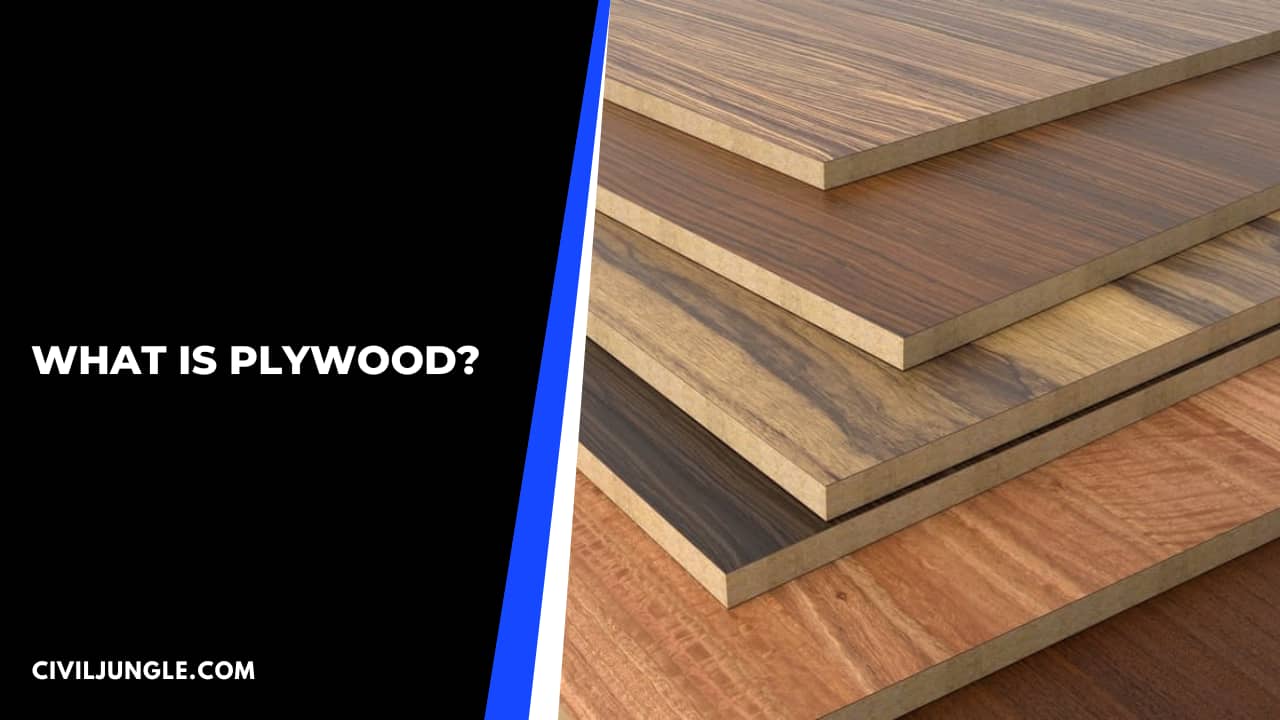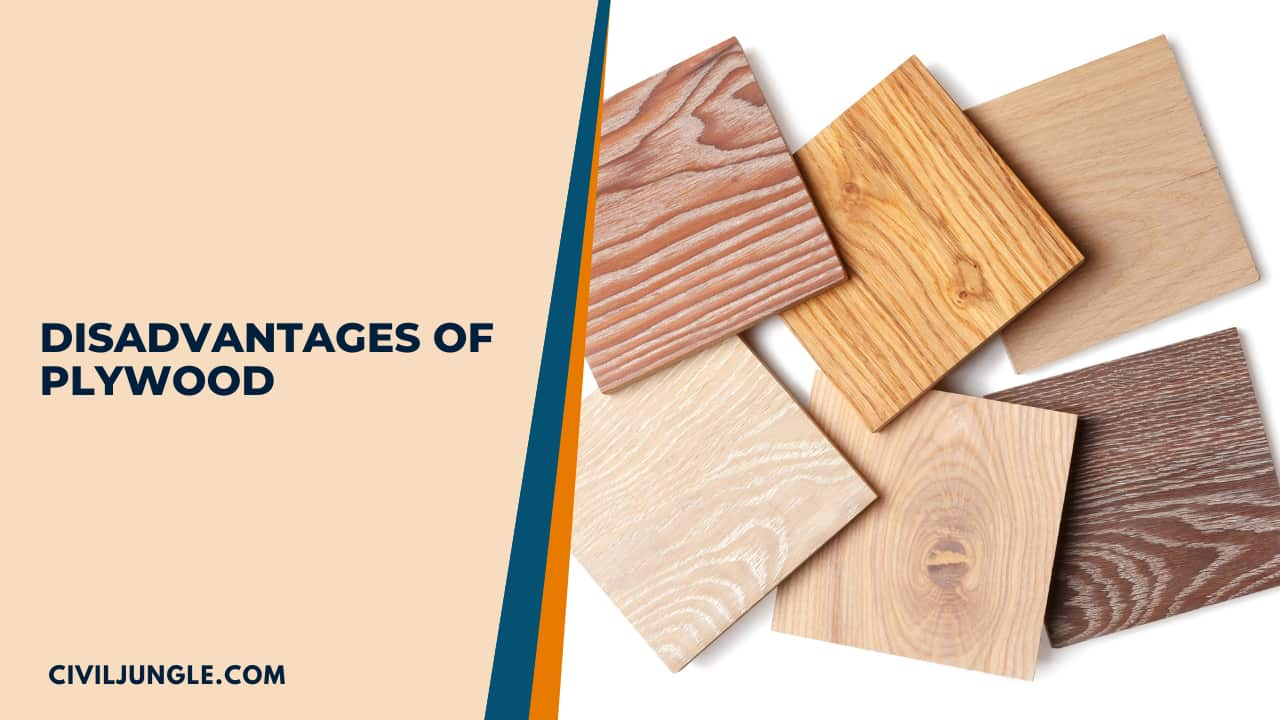What Is MDF?
Important Point
MDF Full Name: Medium-Density Fiberboard
The Medium-Density Fiberboard (MDF) is a designed wood product formed from wood fibers obtained by breaking wood and softwood with a defibrillator.
The wood fibers are then glued using wax and resin adhesive. They are transformed into panels, applying high temperature and pressure.
The resulting smooth wood product has no wood grain and shares many characteristics with particle boards. However, MDF is slightly stronger particleboard.
MDF is a designed wood composite that is similar to the particleboard but is much denser and stronger than the particleboard.
Imagine if all the sawdust has been removed from other wood product manufacturing processes and then the sawdust has been mixed with binders and pressed into large plywood-sized sheets.
Okay, this is very simplified, and it is not exactly the process they use to manufacture MDF, but it gives an idea of the composition of the product.
Because it is composed of such small wood fibers, there is no wood grain in the MDF. And because it is pressed so hard at such high temperatures, there are no gaps in the MDF like those found in the particleboard.
Here you can see the visible difference between the chipboard and the MDF, with the MDF at the top and the chipboard at the bottom.
Also, read: Difference Between Timber And Wood | What is Wood | What is Timber
Advantages of MDF
MDF is generally cheaper than plywood.
The MDF surface is very smooth and you don’t have to worry about knots on the surface.
Because it is so smooth, it is a great surface for painting. I recommend the first conditioning with a quality oil-based primer. (Do not spray the aerosol primers on the MDF! It simply absorbs and is a huge waste of time and money. It will also scratch the )
Also due to its smoothness, MDF is a great substrate for the veneer.
MDF is very consistent, so the cut edges look smooth and free from gaps or splinters
Due to the smooth edges, you can use a router to create decorative edges.
The consistency and smoothness of the MDF allow for easy cutting of detailed designs (such as a roll or cut designs) using a scroll saw, band saw or jigsaw.
Also, read: What Is Seasoning of Timber | Type of Seasoning of Timber | Benefit Seasoning of Timber
Disadvantages of MDF
MDF basically glorified the cluster.
Like the chipboard panel, MDF absorbs water and other liquids like a sponge and swells, unless it is well sealed on all sides and edges with primer, paint or other sealing product. Again, I recommend a quality oil-based primer. No aerosol primers!
As it consists of fine particles, MDF does not hold the screws very well and it is very easy to remove the screw holes.
Because it is so dense, MDF is very heavy. This can make work difficult, especially if you don’t have a helper who can help you lift and cut the large leaves.
MDF cannot be stained. Not only does it absorb the stain like a sponge, but also because there is no wood grain in the MDF, it looks horrible when it is stained. (Sort of like a particle stain. Why would you bother?)
MDF contains VOC (urea-formaldehyde). Gas removal can be greatly minimized (but probably not eliminated) if the MDF is encapsulated with primer, paint, etc. but care must be taken when cutting and sanding to avoid inhaling the particles. I recommend cutting and sanding while using a particle mask.
Also, read: Difference Between Pre-Tensioning and Post-Tensioning | What Is Prestressed | Methods of Prestress
What Is Plywood?
Plywood is made from debarked logs. The thin layers are peeled from the wooden logs, rotating them along their horizontal axis.
The veneer sheets obtained from this process are cut to the desired dimensions, dried, patched, glued and then cooked in a press at 140 ° C (284 ° F) and 1.9 MPa (280 psi) to form a plywood panel.
Depending on the type of plywood, it may or may not be smooth and useful for visually pleasing the internal pieces of wood. Some types of plywood can be stained and made to look good for kitchen cabinets.
Plywood is also a product of engineered wood that is made by pressing and gluing veneer sheets into a single solid piece.
Also, read: Test for Compressive Strength of Brick | Water Absorption | Dimensions Test
Advantages of Plywood
As it consists of layers of wood veneer with the grains in each layer in a different direction, it is a very strong building material.
It is less susceptible to water damage than MDF and does not absorb water and swells as quickly or easily as MDF.
It is sustainable, which makes it perfect for kitchen cabinets, tables and other projects where you want a large stained wood surface.
It holds the screws very tightly, as the varied wood grains in each layer give the screws something to hold.
Although most plywood contains urea-formaldehyde and other VOCs, it is now possible to buy plywood without formaldehyde. Look for the Purebond brand at Home Depot.
Also, read: What Is Bridge Pier | Type of Bridge Pier
Disadvantages of Plywood
It is more expensive than MDF. And obviously, the higher the score and the more special the wood species, the more expensive they become.
Due to the layers displayed on the edge, it is necessary to end the edges in some way. This can be done with iron bands or pieces of wood or decorative moldings.
Plywood usually splinters at the edges when cut, so it is more difficult to achieve a smooth cut with plywood than with MDF.
It is more difficult to cut detailed drawings in plywood (rolled, cut, etc.) because the edges fragment and you get edges that show layers and may have empty spaces in some
Like MDF, most plywood contains urea-formaldehyde and other VOCs that can release gas into your home. Take precautions when cutting.
Also, read: What Is Raft Foundation | Type of Footing | Detail of Raft Footing
MDF Vs Plywood
The plywood comes not only in different thicknesses but also in different degrees, so you can choose the right one for your project.
The lower classes are used in the construction of houses for floors and other things. Obviously, these types of plywood do not have to be beautiful, as they will be covered up.
The highest grades of plywood (grade of stain, the grade of a cabinet, etc.) are much more beautiful and smooth.
They have consistent wood grains and generally have no holes or other major imperfections. And cabinet-type plywood is always sanded very smoothly on the surface.
Best Plywood for Furniture
A-grade: The best plywood for furniture pieces and cabinets, A-grade plywood has a smooth and sanded surface with minor defects. These qualities will reflect in the plywood prices. B-grade: This grade of plywood is similar to the A-grade variety, with a few knots. However, the defects can go up to 1 inch across.
Advantages of Mdf Over Plywood
Advantages of MDF
- MDF is generally cheaper than plywood.
- The surface of MDF is very smooth which makes it a great surface for painting.
- MDF is very consistent throughout, so cut edges appear smooth and won’t have voids or splinters.
- Because of the smooth edges, you can use a router to create decorative edges.
Plywood Vs Mdf for Cabinets
When considering plywood vs MDF (medium-density fiberboard) for cabinets, there are several factors to take into account, including cost, durability, aesthetics, and ease of installation. Let’s explore each of these aspects:
- Cost: Plywood is generally more expensive than MDF. The price can vary depending on the grade and type of plywood, but in general, MDF tends to be more budget-friendly.
- Durability: Plywood is known for its strength and durability. It consists of layers of wood veneers glued together, which gives it good structural integrity. It is less prone to warping or sagging, making it suitable for areas with high moisture or heavy use. MDF, on the other hand, is made from wood fibers and resin, and while it is sturdy, it is more susceptible to moisture damage and can warp or expand if not properly sealed.
- Aesthetics: Plywood has a natural wood grain appearance, which many people find visually appealing. It can be left unfinished or finished with stain or paint to enhance its look. MDF, being a composite material, has a uniform texture and does not have a natural grain. It is typically used when a smooth and consistent finish is desired, such as for painted cabinets.
Mdf Vs Plywood for Shelving
MDF’s softness means that it is likely to sag when used for shelves that will bear heavy weights, so it’s best to only use this wood composite for shelves that will not hold heavy things. Plywood is undeniably the best choice for shelves that will hold many books or other heavy items.
Difference Between Mdf and Plywood
Plywood. Medium-density fiberboard (MDF) is generally cheaper than plywood, but it is not as hard and can sag under heavy weight. MDF doesn’t handle moisture very well, either, so it is more suited for indoor use, such as in furniture.
Mdf Full Form
MDF (Medium Density Fibreboard) is an engineered material made by breaking down hardwood or softwood residuals into fine particles, combining it with wax and a resin binder and applying high temperature and pressure.
Mdf Board Vs Plywood
MDF and Plywood are used on the basis of their properties. MDF board would be the best option if you want a low budget and material for interior application. If you want material for an exterior application that can withstand moisture, then plywood is the best option.
What Is Stronger Mdf or Plywood?
When it comes to strength, plywood is the winner. MDF is a softer material than plywood and tends to sag or split under pressure. That’s why it’s important to reinforce it if you’re going to using it to build shelves or other weight-bearing furniture.
What Is Cheaper Mdf or Plywood?
MDF is generally cheaper than plywood. The surface of MDF is very smooth which makes it a great surface for painting. MDF is very consistent throughout, so cut edges appear smooth and won’t have voids or splinters. Because of the smooth edges, you can use a router to create decorative edges.
What Is Mdf Vs Plywood?
MDF starts off with hardwood and softwood fibers, which are glued together with various resins, and then subjected to high heat and pressure to form panels. Plywood undergoes a similar process, but instead of wood fibers, starts off with very thin layers of wood from peeler logs.
What Is Mdf Used For?
MDF is well damped acoustically, thus making it a suitable material for speaker enclosures. MDF is widely used in the manufacturing of furniture, kitchen cabinets, moldings, millwork, door parts, and laminate flooring.
What Is Mdf Board Made Of?
Medium Density Fibreboard (MDF) is an engineered wood-based sheet material made by bonding together wood fibres with a synthetic resin adhesive. MDF is extremely versatile and can be machined and finished to a high standard.
What Is Cdx Plywood?
CDX Plywood is used primarily by contractors to build exterior walls and roofs. CDX plywood has one side veneer grade “C” and one side veneer grade “D”. The two are bonded together with glue which can withstand a little moisture. The APA would recognize CDX Grade Plywood as C-D Exposure 1 plywood.
Like this post? Share it with your friends!
Suggested Read –
- Acp Boards
- Plywood Strength
- What Is Timber Wood
- What Is Admixture | Types of Admixtures
- Type of Stair | Stairs Parts Names & Details
- Building Estimation Step by Step In Excel Sheet
- What is BoQ | BoQ Meaning | Advantages of BoQ | What is BoM
- Difference Between One Way Slab and Two Way Slab | What is Slab
- Principle of Plane Table Surveying Methods | Equipment | Error | Advantage | Limitation
Originally posted 2023-06-24 12:01:07.








Leave a Reply